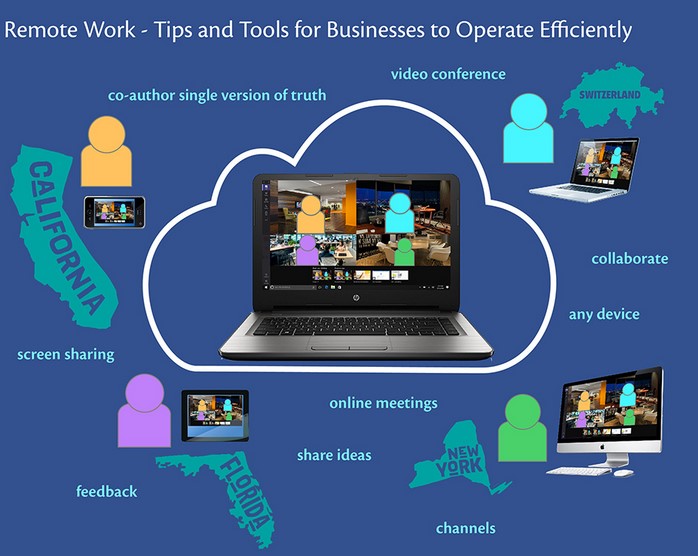Trends and Statistics on Remote Work
The rise of remote work has been one of the most significant workplace trends in recent years, accelerated by the COVID-19 pandemic. According to a survey by Upwork, 36.2 million Americans will be remote by 2025, an 87% increase from pre-pandemic levels. This shift has been driven by factors such as technological advancements, changing employee preferences, and the need for greater flexibility.
Employers have also recognized the benefits of remote work, with 73% of companies planning to offer remote or hybrid work options in the future, according to a Gartner survey. This trend is not limited to specific industries or regions, as companies across various sectors and locations have embraced remote work models.
The benefits of remote work are numerous, including increased productivity, improved work-life balance, reduced commuting costs, and access to a wider talent pool. However, challenges such as potential isolation, communication barriers, and cybersecurity risks must be addressed to ensure a successful remote work experience.
As the world continues to adapt to the new normal, the demand for remote work solutions and the adoption of remote-friendly policies are expected to grow, shaping the future of work for years to come.
Table of Contents
Video Conferencing Tools
Video conferencing tools have become an essential part of remote work, enabling teams to communicate face-to-face and collaborate effectively despite being physically apart. These tools allow for virtual meetings, presentations, and real-time discussions, ensuring seamless communication and fostering a sense of connection among team members.
Some popular video conferencing tools include Zoom, Microsoft Teams, Google Meet, and Skype. These platforms offer features such as screen sharing, virtual whiteboards, and recording capabilities, making it easier to conduct productive meetings, brainstorming sessions, and training sessions remotely.
Additionally, many video conferencing tools integrate with other productivity applications, providing a seamless experience and facilitating collaboration across various platforms.
Tools for Remote Working Task and Time Management

Task and calendar apps are essential for remote workers to stay organized and on top of their responsibilities. Tools like Todoist, Trello, and Asana allow you to create tasks, set due dates, and collaborate with team members. Calendar apps like Google Calendar and Calendly help you schedule meetings, appointments, and block off focus time.
Note-taking tools like Evernote, OneNote, and Notion enable you to capture ideas, take meeting notes, and organize information in a centralized location accessible from anywhere. These tools often integrate with other productivity apps, making it easy to keep all your work-related content in one place.
Pomodoro timers, such as the Pomodoro Technique App and Forest, can help you stay focused and avoid burnout by breaking your work into intervals separated by short breaks. These tools are particularly useful for remote workers who may struggle with distractions or lack of structure.
Distraction blockers like Freedom and Cold Turkey can temporarily block access to specific websites or applications, helping you eliminate online distractions and stay focused on your work. These tools are invaluable for remote workers who find themselves easily sidetracked by social media, news sites, or other online temptations.
Habit trackers like Streaks, Strides, and HabitBull can help you develop and maintain positive routines, such as exercising, meditating, or taking breaks throughout the day. These tools can be particularly beneficial for remote workers who may struggle with maintaining a healthy work-life balance or establishing consistent habits without the structure of an office environment.
Tools for Tracking Productivity, Monitoring Workloads, and Facilitating Feedback
In a remote work environment, it’s crucial to have tools that help track productivity, monitor workloads, and facilitate feedback and recognition. These tools ensure that teams remain aligned, engaged, and motivated, regardless of their physical location.
Productivity Tracking Tools
Productivity tracking tools allow remote teams to monitor their progress, set goals, and measure their achievements. These tools often include features such as time tracking, task management, and project planning. Examples of popular productivity tracking tools include:
- Toggl: A time-tracking tool that helps teams understand how they spend their time and identify areas for improvement.
- Trello: A visual project management tool that allows teams to organize tasks, assign responsibilities, and track progress.
- Asana: A work management platform that helps teams plan, organize, and collaborate on projects.
Workload Monitoring Tools
Workload monitoring tools help managers and team leaders ensure that remote employees are not overworked or underutilized. These tools provide insights into team members’ workloads, allowing for better resource allocation and workload balancing. Some popular workload monitoring tools include:
- Hubstaff: A time-tracking and productivity monitoring tool that provides detailed reports on employee activity, productivity levels, and workloads.
- RescueTime: A time management and productivity tracking tool that helps individuals and teams understand how they spend their time and identify distractions.
- Harvest: A time-tracking and invoicing tool that helps teams monitor workloads, track billable hours, and manage project budgets.
Feedback and Recognition Tools
Remote work can sometimes make it challenging to provide timely feedback and recognize employees’ achievements. Feedback and recognition tools help bridge this gap by creating a virtual space for team members to give and receive feedback, share accomplishments, and celebrate successes. Examples of such tools include:
- Lattice: A performance management platform that facilitates continuous feedback, goal-setting, and recognition.
- Kudos: A peer-to-peer recognition platform that allows team members to give and receive kudos for their contributions.
- 15Five: A continuous performance management tool that includes features for weekly check-ins, feedback, and recognition.
By leveraging these tools, remote teams can maintain high levels of productivity, balance workloads effectively, and foster a culture of feedback and recognition, ultimately contributing to a more engaged and motivated workforce.

Cloud Storage, File Sync, and Secure Collaboration
Cloud storage services have become essential tools for remote work, allowing teams to store, access, and share files from anywhere. Services like Dropbox, Google Drive, and Microsoft OneDrive provide secure, centralized repositories for important documents, enabling seamless collaboration and version control.
File syncing ensures that team members always have access to the latest versions of files across their devices. Cloud storage platforms automatically sync files, eliminating the need for manual file transfers and reducing the risk of working with outdated versions. This streamlines workflows and enhances productivity for remote teams.
Secure file sharing is crucial when working with sensitive or confidential information. Cloud storage platforms offer robust access controls, encryption, and audit trails, ensuring that files are shared only with authorized individuals. Teams can easily share files or folders with specific collaborators, set permissions, and track activity, fostering secure collaboration while minimizing data breaches.
Many cloud storage services also integrate with productivity suites and communication tools, enabling real-time co-authoring, commenting, and chat functionality. This seamless integration enhances collaboration, allowing remote teams to work together efficiently on documents, presentations, and spreadsheets, as if they were in the same physical location.
Virtual Desktop and Meeting Solutions
As remote work continues to gain traction, having the right tools to facilitate seamless collaboration and productivity is paramount. Virtual desktop solutions and remote desktop access have emerged as game-changers, enabling employees to access their work environments from anywhere, anytime, using any device.
These solutions provide a secure and centralized platform for storing and accessing data, applications, and resources, ensuring that sensitive information remains protected while allowing for seamless collaboration. With virtual desktops, employees can enjoy the same user experience as they would in the office, complete with personalized settings, applications, and files.
Moreover, virtual whiteboards and meeting rooms have revolutionized the way teams interact and brainstorm. These digital spaces allow for real-time collaboration, where participants can share ideas, annotate documents, and engage in interactive discussions, regardless of their physical location. Virtual whiteboards offer a dynamic and visually appealing canvas for capturing ideas, while meeting rooms provide a more structured environment for presentations, discussions, and decision-making.
By leveraging these tools, remote teams can foster a sense of community, maintain open lines of communication, and ensure that projects progress efficiently, even in a distributed work environment.
Securing Your Remote Work Setup
As remote work becomes more prevalent, ensuring online security and privacy is crucial. Here are some essential tools to safeguard your digital workspace:
Virtual Private Networks (VPNs): A VPN encrypts your internet connection, protecting your online activities from prying eyes. It’s especially important when using public Wi-Fi networks, as VPNs prevent potential eavesdropping and data theft.
Password Managers: With numerous online accounts, managing complex passwords can be a challenge. Password managers securely store and generate strong, unique passwords for all your accounts, reducing the risk of credential theft.
Antivirus and Malware Protection: Robust antivirus and anti-malware software is a must-have for remote workers. These tools scan your devices for potential threats, safeguarding against viruses, trojans, and other malicious software that could compromise your data or system.
Data Encryption: Encrypting sensitive data, such as documents, spreadsheets, or databases, is essential for protecting confidential information. Encryption tools scramble data, making it unreadable without the proper decryption key, ensuring your files remain secure even if intercepted.
Online Privacy Tools: Various tools and browser extensions can enhance your online privacy. Ad blockers prevent tracking, while privacy-focused search engines and messaging apps prioritize user anonymity and data protection. These tools help minimize your digital footprint and safeguard your personal information.
Ergonomic Tools for Remote Work
When working remotely, it’s crucial to have an ergonomic setup that promotes good posture, reduces strain, and prevents potential injuries. Ergonomic tools can help you create a comfortable and productive work environment, even if you’re working from a makeshift home office or a cozy corner.
Invest in a high-quality ergonomic chair that provides proper lumbar support and adjustable features to align with your body’s natural curves. An ergonomic keyboard and mouse can also alleviate wrist strain and reduce the risk of carpal tunnel syndrome. Consider using a laptop stand or a monitor riser to ensure your screen is at eye level, preventing neck and shoulder discomfort.
Ergonomic tools like wrist rests, footrests, and anti-fatigue mats can further enhance your comfort and well-being during long work sessions. Additionally, explore ergonomic desk converters or adjustable standing desks, which allow you to alternate between sitting and standing positions, promoting better circulation and reducing the risk of sedentary behavior.
Fitness Apps for Remote Workers
Remote work often involves prolonged periods of sitting, which can lead to various health issues if not addressed. Fitness apps can be a convenient and motivating solution to incorporate physical activity into your daily routine.
Look for apps that offer a wide range of workout options, from high-intensity interval training (HIIT) to yoga and strength training. Many fitness apps provide customizable workout plans tailored to your fitness level, goals, and available equipment (or no equipment at all).
Consider apps that gamify the fitness experience, offering challenges, leaderboards, and social features to keep you engaged and motivated. Some apps even integrate with wearable devices or smartwatches, allowing you to track your progress and monitor your fitness metrics.
Remember, regular physical activity not only benefits your physical health but can also improve mental well-being, boost energy levels, and enhance productivity during remote work hours.
Meditation and Mindfulness Apps
Remote work can be mentally demanding, with the blurred lines between work and personal life often leading to stress and burnout. Incorporating meditation and mindfulness practices into your routine can help you manage stress, improve focus, and cultivate a sense of calm amidst the chaos.
Explore apps that offer guided meditations, breathing exercises, and mindfulness techniques suitable for beginners and experienced practitioners alike. Look for apps with a variety of meditation styles, such as body scans, loving-kindness meditations, and mantra-based practices.
Many mindfulness apps also provide tools for tracking your mood, setting reminders for daily practice, and offering insightful content or courses to deepen your understanding of mindfulness principles.
Regularly practicing meditation and mindfulness can help you stay centered, present, and resilient, enhancing your overall well-being and productivity during remote work sessions.
Online Therapy and Counseling
The unique challenges of remote work, such as social isolation, work-life balance struggles, and heightened stress levels, can take a toll on mental health. Online therapy and counseling services offer a convenient and accessible way to seek professional support from the comfort of your remote workspace.
Look for reputable online therapy platforms that connect you with licensed and qualified mental health professionals. These platforms often provide secure video or chat-based sessions, ensuring privacy and confidentiality.
Online therapy can be particularly beneficial for remote workers who may have limited access to in-person counseling services or prefer the flexibility and convenience of virtual sessions. It can help address a wide range of concerns, including anxiety, depression, relationship issues, and workplace stress.
Remember, seeking professional support is a proactive step towards maintaining good mental health, which is essential for thriving in a remote work environment.
Home Office Equipment and Hardware for Remote Work
Working remotely requires the right tools and equipment to create an efficient and productive home office setup. From ergonomic chairs and standing desks to noise-canceling headphones and high-quality webcams, having the proper hardware can significantly enhance your remote work experience.
Ergonomic Chairs and Standing Desks: Investing in an ergonomic chair and a standing desk can help prevent back pain, neck strain, and other posture-related issues that can arise from prolonged sitting. Look for chairs with adjustable lumbar support, seat height, and armrests, and consider a standing desk that allows you to alternate between sitting and standing positions throughout the day.
Noise-Canceling Headphones: In a remote work environment, background noise can be a significant distraction. Noise-canceling headphones can help you stay focused by blocking out external sounds, whether it’s traffic, construction, or household noises. Look for headphones with active noise cancellation technology and a comfortable fit for extended wear.
High-Quality Webcams: Clear video and audio quality are essential for effective virtual meetings and collaborations. Invest in a high-quality webcam with a good resolution, wide field of view, and built-in noise-canceling microphones. This will ensure that you look and sound professional during video calls and presentations.
Lighting Equipment: Proper lighting can significantly improve the quality of your video calls and presentations. Consider investing in a ring light or desk lamp with adjustable brightness and color temperature settings. This will help you look your best on camera and avoid unflattering shadows or glare.
External Monitors: If you frequently work with multiple applications or documents simultaneously, an external monitor can be a game-changer. Dual or even triple monitor setups can boost productivity by allowing you to easily switch between tasks and have more screen real estate for multitasking.
Wireless Keyboard and Mouse: Ditch the tangled wires and opt for a wireless keyboard and mouse combo. These not only provide a clutter-free workspace but also offer greater flexibility and mobility, allowing you to work comfortably from different areas of your home office.
By investing in the right home office equipment and hardware, you can create a productive and comfortable remote work environment that supports your needs and helps you stay focused and efficient.
Creating Remote Work Policies
As more companies embrace remote work, it’s crucial to establish clear policies to ensure a productive and cohesive work environment. Remote work policies should cover expectations, communication guidelines, security measures, and employee support.
Start by defining the scope of remote work arrangements, whether it’s fully remote, hybrid, or location-based. Outline expectations for availability, response times, and meeting attendance. Establish communication protocols, such as preferred channels for different types of communication and guidelines for virtual meetings.
Cybersecurity is a critical consideration for remote teams. Implement measures like virtual private networks (VPNs), multi-factor authentication, and secure file-sharing platforms. Provide training on identifying and preventing cyber threats, and ensure that employees use company-approved devices and software.
Lastly, address employee well-being and work-life balance. Encourage regular breaks, offer resources for ergonomic home setups, and promote mental health support. Foster a culture of trust and flexibility, recognizing that remote work may require adjustments to traditional schedules and work styles.



